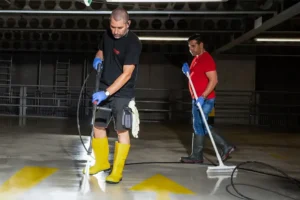In high-risk environments such as construction sites, manufacturing units, mining operations, and chemical plants, worker safety isn’t just a priority—it’s a necessity. These settings often expose individuals to hazardous materials, machinery, or conditions that demand strict compliance with personal protective equipment (PPE) protocols. However, traditional methods of ensuring PPE compliance—like manual supervision—are increasingly proving to be inadequate in large-scale, fast-paced operations. This is where PPE Detection technology steps in as a transformative solution.
The Evolution of Safety Protocols
For decades, the enforcement of PPE usage relied heavily on human observation. Supervisors or safety officers monitored whether workers wore helmets, reflective vests, gloves, goggles, or face shields. But manual checks have limitations. Human oversight can be inconsistent, and in environments with hundreds of personnel and multiple access points, ensuring 100% compliance is nearly impossible. Moreover, traditional methods don’t offer real-time alerts or data insights—both of which are critical for timely intervention and long-term safety strategy.
With the advent of AI and computer vision, safety monitoring has entered a new era. Modern PPE Detection systems use intelligent cameras and software that can instantly identify whether a person is wearing the required protective gear. This detection occurs in real-time, allowing for immediate response and documentation.
How PPE Detection Works
PPE Detection relies on artificial intelligence models trained to recognize various types of safety equipment. High-resolution cameras installed in key areas—such as entry points, operational zones, and assembly lines—continuously scan the field of view. The AI system analyzes the visual data frame-by-frame, identifying the presence or absence of specific PPE like helmets, safety glasses, high-visibility jackets, or masks.
The system does not require any physical interaction or manual tagging. It automatically flags non-compliance, sends alerts to supervisors, and records the incident for reporting. In some cases, the software integrates with access control systems, denying entry to workers not wearing the required gear. This automation drastically reduces the chances of human error while creating a more secure work environment.
Enhancing Accountability and Culture of Safety
One of the less discussed but equally important benefits of PPE Detection systems is their role in shaping workplace behavior. When workers are aware that safety protocols are monitored consistently and objectively, compliance tends to improve. The fear of reprimand or penalties is replaced by a more responsible and proactive attitude toward safety.
Furthermore, these systems generate data that can be analyzed for trends. For instance, if a specific shift or department consistently shows higher instances of non-compliance, management can take targeted action—whether it’s providing better training, upgrading PPE, or improving signage. This proactive approach leads to a measurable improvement in workplace safety culture.
Real-Time Alerts and Instant Corrections
Speed is crucial in environments where a momentary lapse can result in serious injury or even death. Real-time alerts offered by PPE Detection systems provide an immediate advantage. When non-compliance is detected, the system can send instant notifications through connected platforms—whether that’s a dashboard, a mobile app, or an integrated alert system in the control room.
These alerts can be customized based on severity. For example, failure to wear a helmet in a low-risk area might result in a warning, while the same violation in a high-risk zone could trigger an automatic shutdown or intervention. This tiered response ensures that safety is maintained without unnecessary disruptions.
Integration with Broader Safety Infrastructure
Modern PPE Detection technologies are not standalone tools. They can be integrated seamlessly into a facility’s broader safety and operational infrastructure. For instance, many systems support APIs for integration with access control systems, HR databases, or even attendance logs. This allows organizations to create a centralized safety dashboard where PPE compliance, incident reporting, and personnel data coexist in a unified interface.
Moreover, these systems can be linked to environmental sensors that detect temperature, humidity, toxic gases, or noise levels. When paired with PPE detection, this provides a comprehensive safety management solution that not only ensures gear compliance but also adjusts protocols based on environmental risks.
Industry Applications of PPE Detection
The versatility of PPE Detection systems makes them ideal for a wide range of industries. In the construction sector, where falling objects and heavy machinery pose constant threats, PPE detection ensures that helmets, vests, and gloves are always in place. Manufacturing plants, especially those dealing with chemicals or heavy fabrication, benefit from ensuring that masks, protective suits, and eye gear are used without fail.
Mining operations, which often occur in remote and poorly lit areas, gain an edge with infrared-capable detection systems that function even in low-light conditions. Meanwhile, healthcare facilities, especially during pandemics, use PPE detection to ensure masks and face shields are worn correctly by staff and visitors alike.
Final Thoughts
As industries continue to evolve and become more complex, the need for robust safety solutions will only grow. PPE Detection is no longer a luxury or an experimental technology—it is rapidly becoming a critical component of occupational safety strategies worldwide. By offering real-time insights, fostering accountability, enabling compliance, and supporting predictive safety, PPE Detection helps protect what matters most: human lives.
Investing in such systems not only demonstrates an organization’s commitment to safety but also boosts operational efficiency, morale, and long-term resilience. In high-hazard zones, where the stakes are immeasurably high, PPE Detection stands as a silent guardian—watchful, accurate, and ever-reliable.



